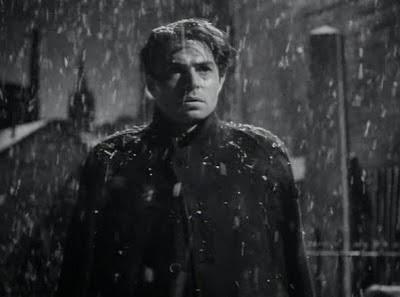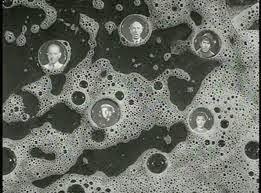
"Close the door when I'm gone, and forget me."
Carol Reed's first masterpiece is Odd Man Out (1947). It's just as stylish as The Third Man but even more affecting: structured like a classic tragedy, Reed promises genre thrills before descending into a snow-blown hell.Johnny Macqueen (James Mason) leads several IRA gunmen in a Belfast bank robbery. During their escape, Johnny is shot and left behind. Johnny tries hiding from authorities, fleeing across the city while nursing a wound. Various characters, some helpful and others suspicious, encounter Johnny while his confederates and police try to reach him.
Odd Man Out starts as a standard thriller, then immediately subverts expectations. The heist occurs ten minutes in, our hero is crippled and reduced to a walking Macguffin. Obvious plot developments are foiled: the police quickly neutralize Johnny's cell, leaving his girlfriend Kathleen (Kathleen Ryan) to try rescuing him. Avoiding political statements, Reed makes Johnny a reluctant terrorist, devoted to Irish freedom but lamenting violence. Yet Reed surprises by rendering the IRA and their police nemesis (Denis O'Dea) equally sympathetic.
Odd Man Out probes ordinary citizens caught in-between An old woman (Maureen Delaney) tips off the cops; loopy artist Lukey (Robert Newton) just wants to paint Johnny's portrait. Most try not to involve themselves, like Maude (Beryl Measor) and Maureen (Ann Clery), two kindly ladies who dress Johnny's wounds, then fret over the terrorist in their midst. Johnny, unwilling to entrap innocents in his fight, politely excuses himself. This touches Maude's previously-hostile husband (Roy Irving), who offers Johnny a cap, a drink and even disposes of his pistol. This vignette exhibits more humanity than most full-length movies.

James Mason gets enough characterization early on that we empathize with his plight. Mason conveys anguish and guilt, hoping for redemption. Kathleen Ryan is likeable, if not so fleshed out. Robert Newton gets the showiest role as a mad artist, but other costars register better: Cyril Cusack's hard-edged terrorist, Denis O'Dea's taciturn cop, William Hartnell's conflicted friend, Beryl Measor and Ann Cleary's befuddled civilians.
Odd Man Out's bleakness probably accounts for its obscurity. It's not as "fun" as The Third Man, with the amiably monstrous Harry Lime and playful zither music. But its peerless direction, rich character cameos and relentless doom make Odd Man Out a masterpiece on its own.

